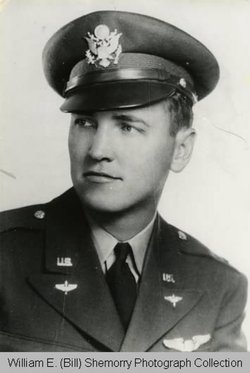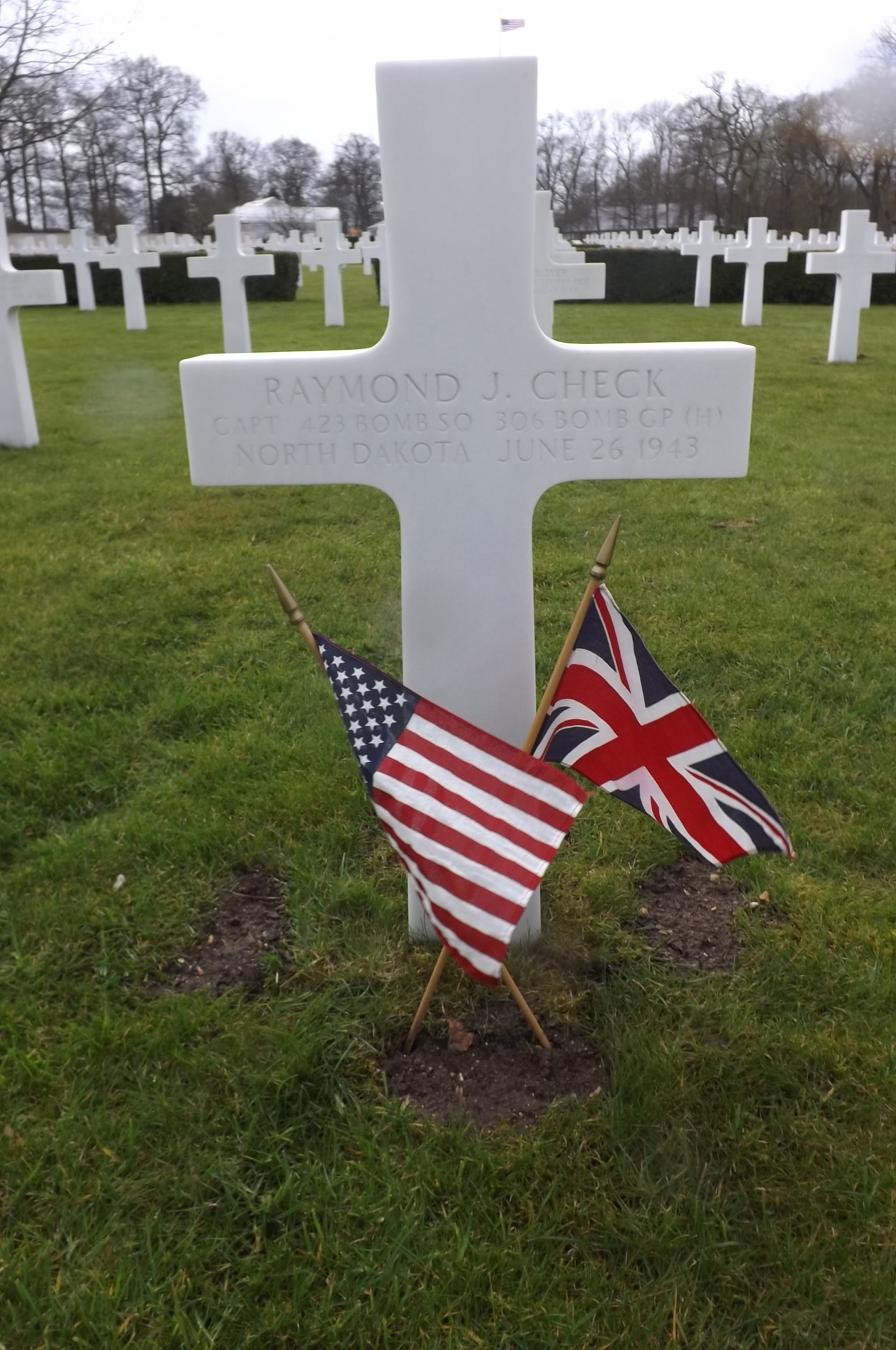Service # O-435856
He entered the Service from North Dakota
Awards: Distinguished Flying Cross, Air Medal with 3 Oak Leaf Clusters, Purple Heart
He was born on September 27, 1917 in North Dakota. His mother was born in Russia and his father was born in Poland. A later census shows they were German speakers both born in Germany. It was probably a case of shifting borders. His father worked as a railroad road master. Raymond had two older sisters and two older brothers. More about the brothers shortly.
He enlisted in the Army Air Forces on June 11, 1941. He became a captain and pilot in the 423rd Bombardment Squadron, 306th Bombardment Group, 8th Air Force which was equipped with B-17 Flying Fortresses.
In the summer of 1943 airmen were given the opportunity to go home after twenty-five missions. Captain Check took off on his twenty-fifth mission on June 26, 1943, flying Chennault's Pappy III. It was a milk-run bombing mission of a German airfield in France. A big party was planned for the evening of their return.
During the bomb run, Check's temporary co-pilot, Lt. Col. James W. Wilson (an old squadron leader who wanted to go on Check's final mission), removed his gloves to make some adjustments to the engine. During the final seconds of the bomb run a German fighter swooped down unnoticed from the sun. One 20mm cannon shell hit Cap. Check in the neck, exploded and killed him. A fire started in the cockpit, badly burning Wilson's hands. A crewmate put out the fire with an extinguisher. Col. Wilson continued flying with a melted oxygen mask, steering with his arms above the elbows since his hands were too badly burned. Still under attack, a machine gun bullet hit the box of flares behind the pilot's seat. The flares exploded created another fire and blowing open the bomb bay doors. Fortunately, there was a third pilot on board -- Lt. William Cassedy, Check's normal co-pilot, was acting as a waist gunner.
Cassedy replaced Wilson in the co-pilot seat. With only one other uninjured man on board, Cassedy brought Chennault's Pappy III back to base. The radio was out and there were no remaining flares to announce an emergency landing. Instead of landing the plane into the wind as normal, Cassedy purposefully landed the plane downwind against incoming traffic. He wanted to avoid the reception group waiting to celebrate Check's 25th mission. It included an American army nurse who was going to marry Captain Check the next day.
His older brother Leonard was also an aviator and no ordinary one at that. At the start of the war he was a fighter pilot on the USS Enterprise. He participated in the Battle of Midway, Battle of Eastern Solomons, Battle of Santa Cruz Island and many others. He transferred to the USS Hancock and attained the rank of Lieutenant Commander and squadron leader. During his career he shot down 12 Japanese planes, including four on one mission. He was highly decorated, having earned the Navy Cross, Distinguished Flying Cross, Silver Star, and Legion of Merit. He died on January 5, 1945 in a midair collision with his wingman over the Philippines. His cenotaph memorial is at the National Memorial Cemetery of the Pacific in Honolulu.
Raymond's other brother Gilbert was a colonel who served in both WW2 and Korea where he earned the Distinguished Service Cross and Silver Star. He died in 1987 and is buried in Arlington National Cemetery.
[Biography written by Command Sergeant Major Dwight "Andy" Anderson.]
Service # O-435856
He entered the Service from North Dakota
Awards: Distinguished Flying Cross, Air Medal with 3 Oak Leaf Clusters, Purple Heart
He was born on September 27, 1917 in North Dakota. His mother was born in Russia and his father was born in Poland. A later census shows they were German speakers both born in Germany. It was probably a case of shifting borders. His father worked as a railroad road master. Raymond had two older sisters and two older brothers. More about the brothers shortly.
He enlisted in the Army Air Forces on June 11, 1941. He became a captain and pilot in the 423rd Bombardment Squadron, 306th Bombardment Group, 8th Air Force which was equipped with B-17 Flying Fortresses.
In the summer of 1943 airmen were given the opportunity to go home after twenty-five missions. Captain Check took off on his twenty-fifth mission on June 26, 1943, flying Chennault's Pappy III. It was a milk-run bombing mission of a German airfield in France. A big party was planned for the evening of their return.
During the bomb run, Check's temporary co-pilot, Lt. Col. James W. Wilson (an old squadron leader who wanted to go on Check's final mission), removed his gloves to make some adjustments to the engine. During the final seconds of the bomb run a German fighter swooped down unnoticed from the sun. One 20mm cannon shell hit Cap. Check in the neck, exploded and killed him. A fire started in the cockpit, badly burning Wilson's hands. A crewmate put out the fire with an extinguisher. Col. Wilson continued flying with a melted oxygen mask, steering with his arms above the elbows since his hands were too badly burned. Still under attack, a machine gun bullet hit the box of flares behind the pilot's seat. The flares exploded created another fire and blowing open the bomb bay doors. Fortunately, there was a third pilot on board -- Lt. William Cassedy, Check's normal co-pilot, was acting as a waist gunner.
Cassedy replaced Wilson in the co-pilot seat. With only one other uninjured man on board, Cassedy brought Chennault's Pappy III back to base. The radio was out and there were no remaining flares to announce an emergency landing. Instead of landing the plane into the wind as normal, Cassedy purposefully landed the plane downwind against incoming traffic. He wanted to avoid the reception group waiting to celebrate Check's 25th mission. It included an American army nurse who was going to marry Captain Check the next day.
His older brother Leonard was also an aviator and no ordinary one at that. At the start of the war he was a fighter pilot on the USS Enterprise. He participated in the Battle of Midway, Battle of Eastern Solomons, Battle of Santa Cruz Island and many others. He transferred to the USS Hancock and attained the rank of Lieutenant Commander and squadron leader. During his career he shot down 12 Japanese planes, including four on one mission. He was highly decorated, having earned the Navy Cross, Distinguished Flying Cross, Silver Star, and Legion of Merit. He died on January 5, 1945 in a midair collision with his wingman over the Philippines. His cenotaph memorial is at the National Memorial Cemetery of the Pacific in Honolulu.
Raymond's other brother Gilbert was a colonel who served in both WW2 and Korea where he earned the Distinguished Service Cross and Silver Star. He died in 1987 and is buried in Arlington National Cemetery.
[Biography written by Command Sergeant Major Dwight "Andy" Anderson.]
Sponsored by Ancestry
Advertisement
Advertisement




